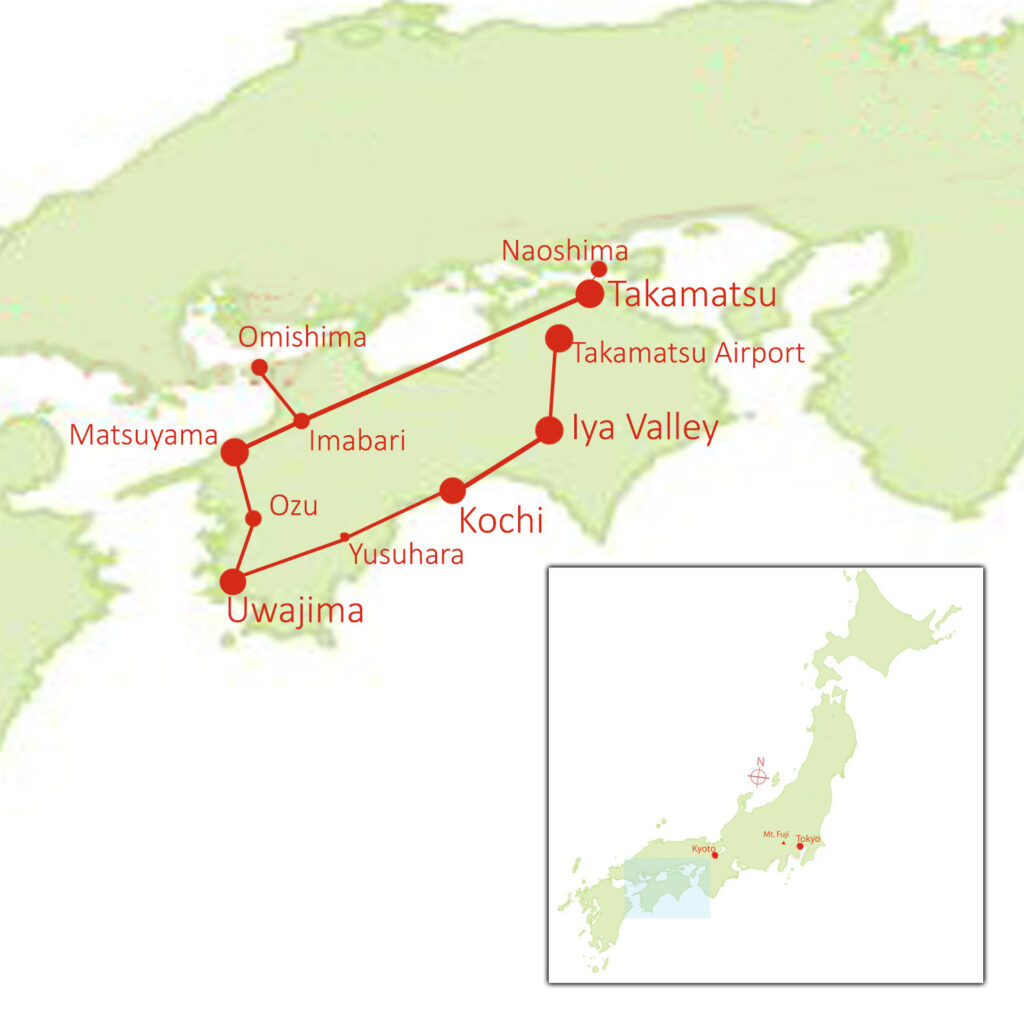Menu
2024 Architecture Tour of Shikoku Japan
2024 Architecture Tour of Shikoku Japan
A once-in-a-lifetime journey to experience the best of Japan’s traditional and contemporary architecture. Travel through spectacular landscapes of valleys and mountains, and stay in designer-styled accommodation in charming historic towns.
“Journey to the East puts their heart and soul into creating wonderful times for visitors to Japan. They know it well and share the best of it with you….”
– Frances Miller
Menu
ようこそ
welcome
Top Tour Highlights
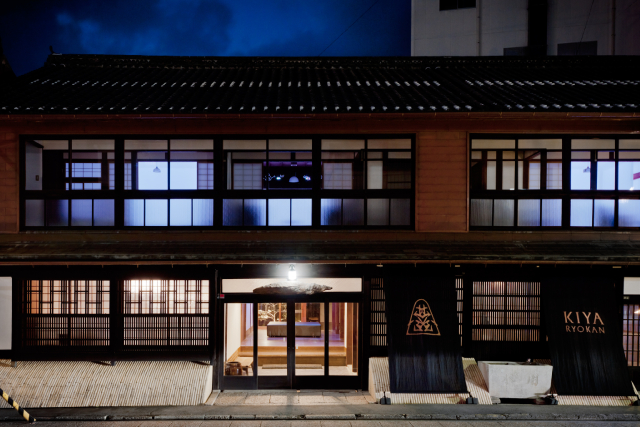
Kiya Ryokan in Uwajima
Visiting regional towns taking the lead in heritage preservation and sustainability
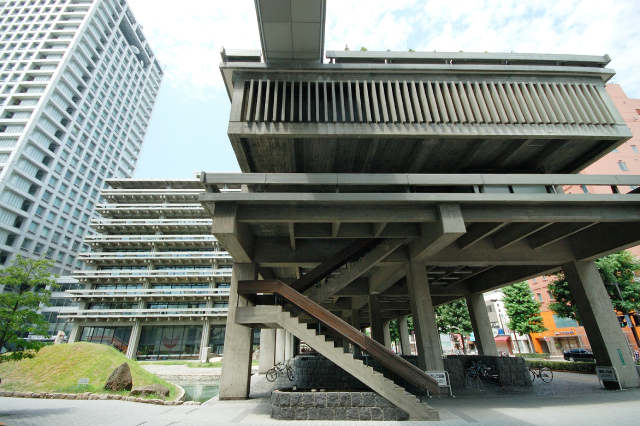
Kagawa Prefecture Government building
Admiring the master pieces of Japan's leading modern architects

Iya Valley
Discovering unspoiled remote landscapes of Shikoku such as Iya Valley

Shimanami Kaido Bridges
Enjoying spectacular views of the bridges linking the islands of the Seto Inland Sea
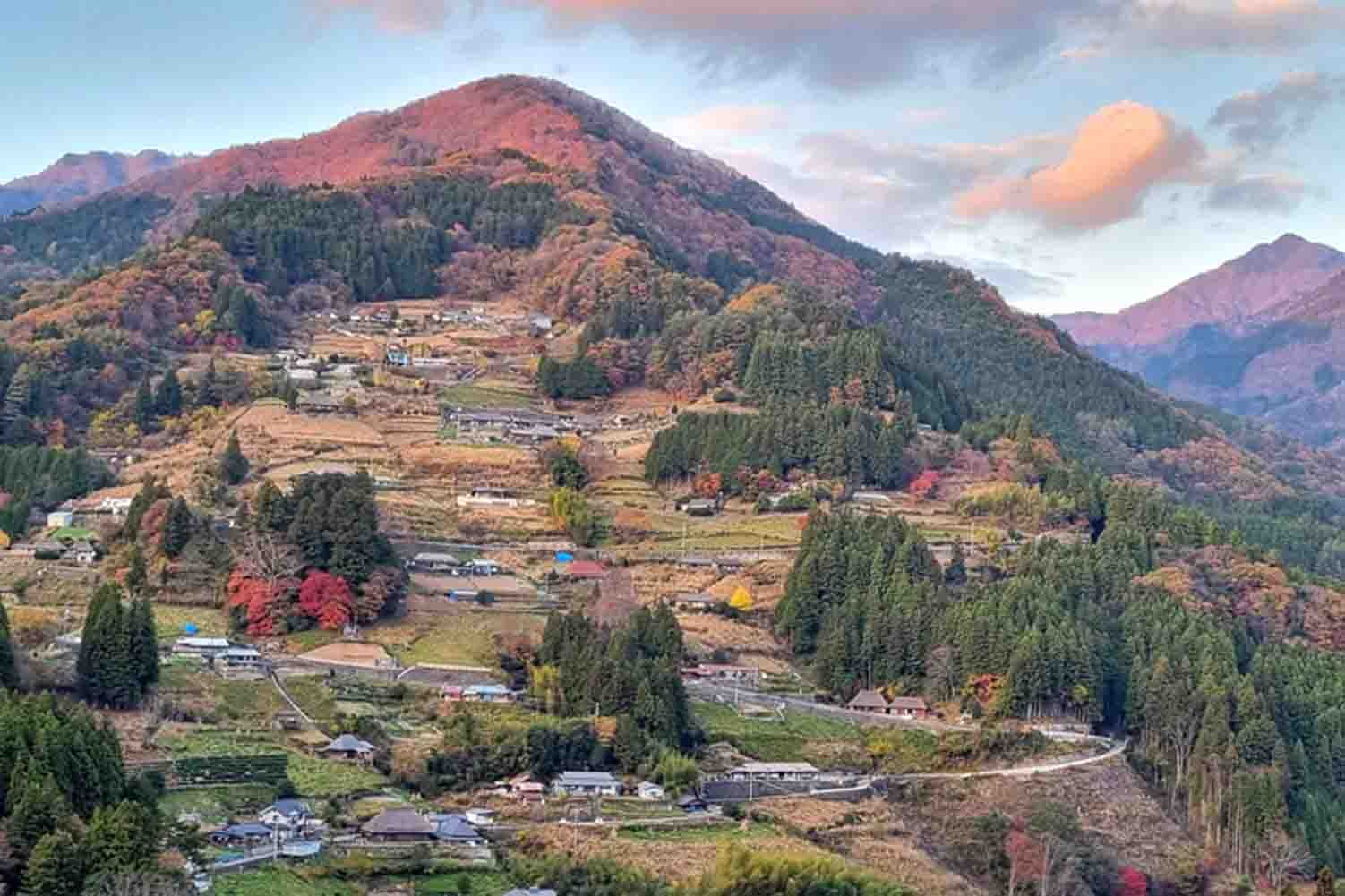
Ochiai Village
Staying at some truly unique accommodation including a thatched roof cottage in the beautiful Ochiai Village.
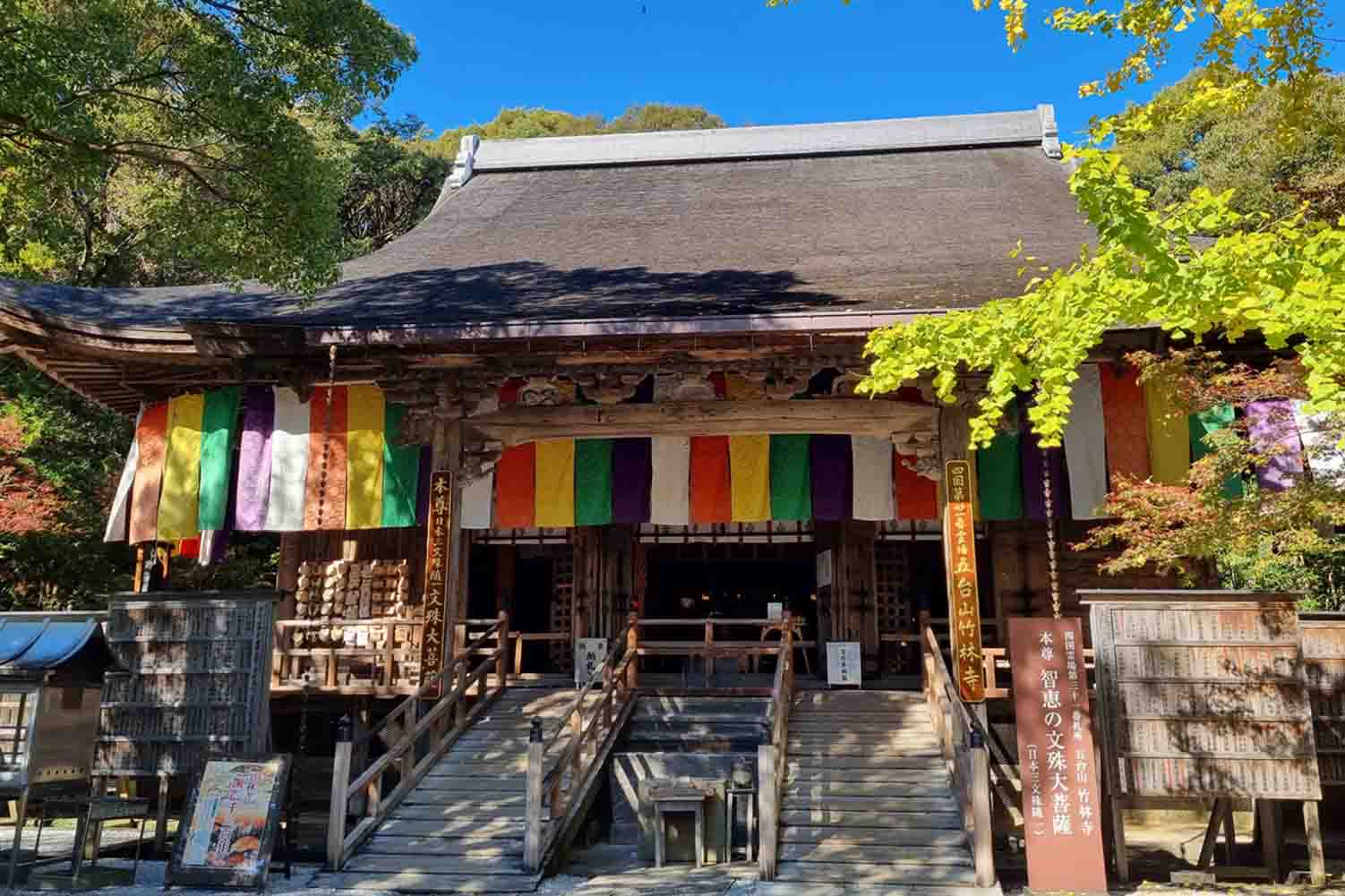
Chikurin-ji temple in Kochi
Learning about the distinctively Buddhist and Shinto architecture with visits to some of Shikoku’s most sacred temples and shrines
ようこそ
welcome
Tour Overview
The 2024 Architecture Tour Shikoku Japan has been specifically designed to showcase Japanese architecture – both traditional and contemporary – on the enchanting island of Shikoku, the smallest of Japan’s four main islands. Responding to popular demand (in 2023 the tour sold out in 48 hours with a long waitlist!), we are offering two departures this year, one in April and the other in November.
Shikoku’s relative isolation has meant that old traditions and ways of life are still visible today, making it the perfect place to discover a more traditional Japan. You will learn how culture and climate have influenced the built environment as well as seeing the works of Japan’s modern-day architects such as Kengo Kuma, Tadao Ando and Kenzo Tange. You will tour through areas of great natural beauty – misty mountains and river valleys, charming historical towns, and the art islands and fishing villages of the Seto Inland Sea.
This special 15-day tour of Shikoku is offered to only 6 people at each departure due to the limited availability of the unique experiences and accommodation selected, as well as the accessibility of the remote locations.
*Shikoku was named by Lonely Planet as one of the ten most interesting global regional destinations in its Best in Travel publication.
*Please note we are unable to accept solo travelers on this tour due to rooming constraints.
Itinerary
Day 1: Arrival in Tokyo
Welcome to Japan! On arrival at Tokyo’s Haneda International Airport, you will be met by a Journey to the East guide and escorted to your airport hotel. Those landing at Tokyo’s Narita Airport will also be met on arrival and escorted to your hotel at Haneda by airport bus.
Today is an arrival day and no group program is scheduled. Your hotel is located at Haneda International Airport given the early start of the tour on Day 2. However if you have time, you might like to consider a short trip into central Tokyo before the start of your 2024 Architecture Tour Shikoku Japan.
*Many of our guests arrive a day or so early to settle in before the tour starts. Please contact us if you’d like us to arrange additional night’s accommodation in the same room as the tour or in central Tokyo.
Haneda (Hotel Villa Fontaine Grand Haneda or similar)
No meals
Day 2: Takamatsu and Iya Valley
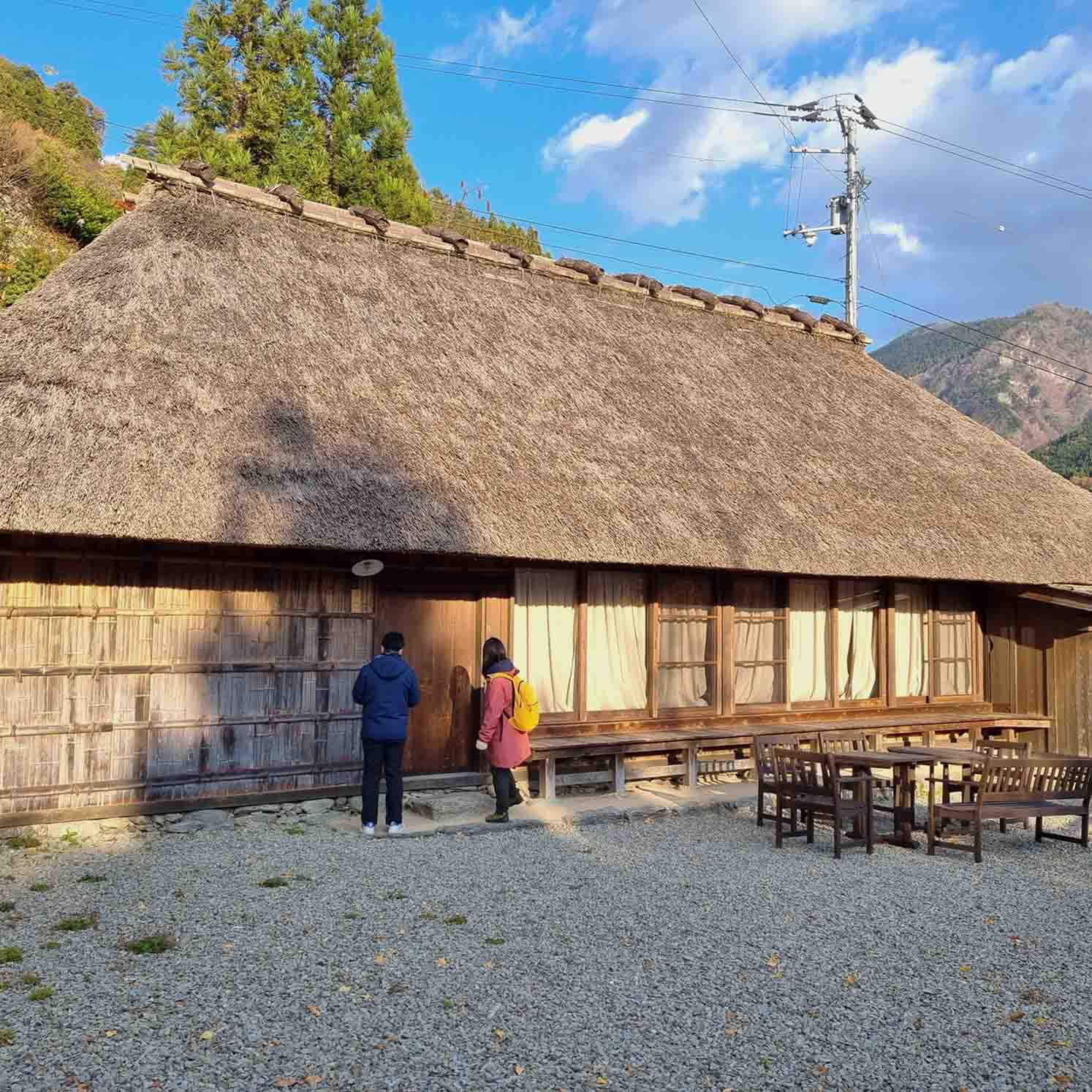
You leave Haneda this morning to fly to Shikoku island, the smallest of Japan’s four main islands and the fascinating base for our island adventure. On arrival in attractive Takamatsu, you’ll be welcomed by your guide and travel by private vehicle to the old shrine town of Kotohira. Here you stop for a traditional lunch of Sanuki udon noodles, the region’s most famous dish.
You will see other pilgrims, and walk with them on the well-worn path up 785 stone steps to Konpira-san, Shikoku’s beloved shrine dedicated to the god of seafarers. Here you will:
- Learn about traditional Shinto shrine architecture and the etiquette of visiting a shrine
- See the magnificent painted door screens by famous artist Maruyama Okyo in the shrine’s Reception Hall, a nationally designated Important Cultural Property
- Admire impressive views all the way to the Seto Inland Sea!
Back in our private vehicle, you head to magical Iya Valley, deep in the heart of the Shikoku mountains. Here you enjoy a truly unique experience for two nights in a beautifully renovated traditional thatched roof cottage in the remote village of Ochiai. Step into your cottage and the stresses of the last few days of international travel will evaporate. You’ll be instantly calmed by the stunning views and hovering mist, the warmth of the traditional interiors and welcoming irori hearth, as well as the quality of the modern amenities. Enjoy a catered dinner cooked by locals using freshly harvested ingredients from the village before a long and comfortable sleep.
Ochiai Village (Togenkyo Iya Mountain Village or similar)
Breakfast, Lunch, Dinner
Day 3: Iya Valley
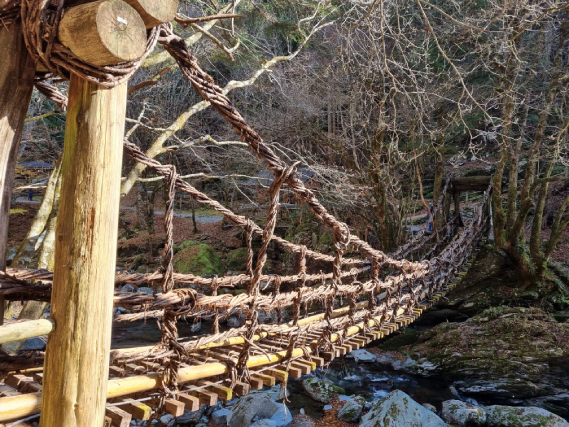
Today is a day of full immersion into local rural life. It begins with a tour of Ochiai with a local resident who will give an insight into village life and how the Chiiori Trust project, initiated by writer Alex Kerr many years ago, has saved and breathed new life into the village’s thatched roof houses. Visitors from across Japan and the world now visit for the rare opportunity to stay in one of these houses, which have almost disappeared from Japan’s rural landscape.
For lunch you are introduced to soba (buckwheat) and participate in a soba noodle making experience where you learn how to make (and properly slurp!) these delicious noodles. After lunch you head deeper into the valley by private vehicle to visit spectacular Niju-Kazura Bridge, a unique pair of twisted vine bridges constructed hundreds of years ago across a deep river gorge. Then it’s on to the “scarecrow village” of Nagoro where an enterprising local has playfully recreated her fellow residents in surreal lifelike form.
Dinner is local style BBQ at your accommodation.
Ochiai Village (Togenkyo Iya Mountain Village or similar)
Breakfast, Lunch, Dinner
Day 4: Iya Valley and Kochi
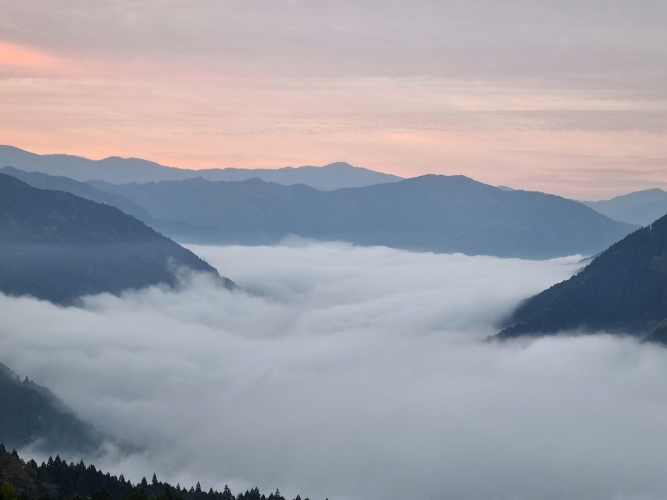
You rise before dawn for a once in a lifetime experience, unkai, a natural phenomenon found in mountainous regions and known as “sea of clouds” (if we are lucky!). Then it’s back to our cottages for a warming cup of coffee and breakfast!
You spend the day exploring central Shikoku as you travel along scenic mountain roads from Iya into neighbouring Kochi. Along the way you will;
- Visit Oboke Gorge and see another unique vine bridge and the equally unique 'Peeing Boy' statue!
- Cruise the pristine waters of the Yoshino River
- Learn how to make “vegetable sushi”, another specialty of this mountainous region
- Experience by candle-light the richly decorated folding screens depicting local folklore at Ekin Museum
For the next two nights you stay in Kochi City – the prefecture’s vibrant capital on the Pacific Ocean coast. For dinner, head to the city’s ever-popular Hirome Ichiba, a marketplace full of food stalls and restaurants open all hours. A great place to sample the freshest of seafoods and other local specialties!
Kochi (Richmond Hotel Kochi or similar)
Breakfast, Lunch, Dinner
Day 5: Kochi
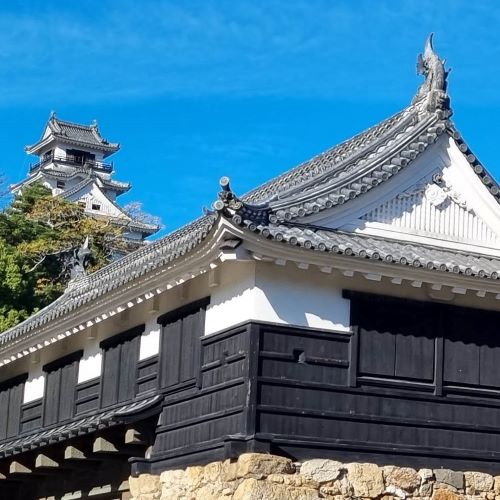
Kochi is home to one of Japan’s last surviving original castles and this morning you visit this authentic example of feudal architecture. Kochi Castle functioned as both a military fortress and residence for the daimyo lords who once ruled the region. Its design is therefore quite unique, as most lords lived in palace buildings separated from their castle.
After a morning steeped in Japan’s military past, you:
- Tour Kochi’s iconic Sunday Market (dating back some 300 years!), selling everything from fresh food and produce to craft and kitchen knives
- Visit revered Chikurin-ji, one of the 88 temples on the Shikoku Pilgrimage, to learn about Buddhist temple architecture and engage in a meditation session
- Stroll through one of Japan’s best Botanical Gardens, Makino and find out more about Shikoku’s local flora as well as exotic species
- Enjoy the sea views of beautiful Katsurahama with its sandy beach and pine trees and statue of Kochi’s most famous son (samurai-hero Sakamoto Ryoma)
You have a free evening to relax or perhaps seek out a tasty izakaya in Kochi’s central town area.
Kochi (Richmond Hotel Kochi or similar)
Breakfast
Day 6: Nakatsu Gorge and Yusuhara
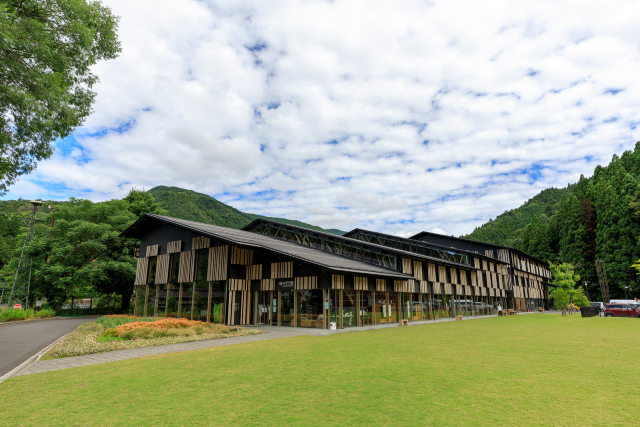
You leave the coast this morning to explore Kochi’s scenic interior region. One of the rivers in this part of Kochi is ranked as one of Japan’s most beautiful, famous for its vibrant cobalt-blue colour. You walk along Nakatsu Gorge to experience the river’s crystalline waters. On the way, you tour some unique “chinkabashi” submersible bridges which have been ingeniously designed to cope with heavy seasonal rains.
The abundance of pristine water in this region has also fostered a strong washi paper-making culture and you enjoy an authentic hands-on experience in a lovely rural setting.
Next stop is Yusuhara – a small mountain town which has become famous for its innovative public buildings, constructed as part of a regional revitalization project. Designed by architect Kengo Kuma (who designed Tokyo’s 2020 Olympics Stadium), the buildings feature wooden exteriors using repurposed cedar and have a strong eco-friendly focus. You are given a guided tour of the town’s most notable buildings.
You overnight at the stunning Marche Yusuhara, another Kengo-designed structure built in his trademark minimalist style. Enjoy a grilled yakiniku dinner and don't forget to appreciate the starry night skies – the town is nicknamed “town above the clouds”!
Yusuhara (Marche Yusuhara or similar)
Breakfast, Lunch, Dinner
Day 7: Uwajima

Enjoy a leisurely start to the day. Perhaps stroll the local streets and stop by one of Yusuhara’s atmospheric cafes.
In the late morning, you leave the mountains behind and head for the charming historical towns of Ehime Prefecture. Your main destination today is the castle town of Uwajima. On the way, you’ll also make a brief stop at Kihoku Town Hall. Originally built in 1958, this building has received acclaim in recent years for the integrity of its 1950s-style architecture.
Depending on time and interest, on arrival in Uwajima you will:
- Explore Uwajima Castle, a delightful compact fortress perched on a hill looking out to sea
- Visit the ancient Shinto fertility shrine of Taga and its unusual sex museum
- Experience Uwajima’s pearl-farming culture, one of Japan’s oldest
- Savour Uwajima’s famous signature dish – tai meshi (sea bream sashimi on rice)
Tonight’s accommodation ranks as another key highlight of our tour. Kiya Ryokan is a century-old ryokan inn which has been painstakingly restored to combine stylish modern amenities within a traditional aesthetic. It has been selected as a nationally registered Tangible Cultural Property and you will meet with the manager for a personal tour of the property and insights into the renovation process.
Uwajima (Kiya Ryokan or similar)
Breakfast, Lunch, Dinner
Day 8: Uchiko and Ozu
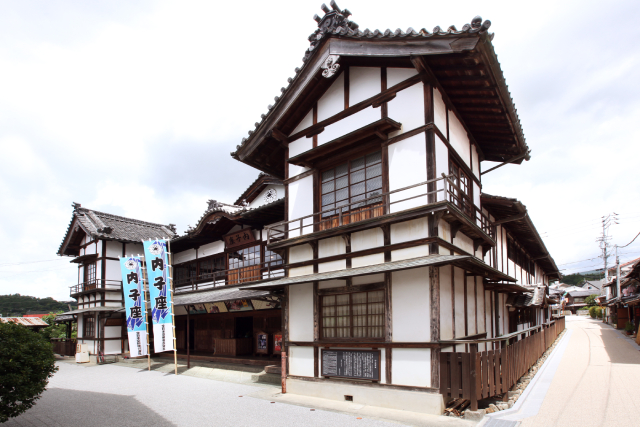
This morning you head by private vehicle to delightful Uchiko, a former merchant town which flourished during the Edo period (17th-19th centuries). Wealth from the Japanese wax trade led to a building boom and its elegant streetscape is now a preservation district – Uchiko was one of Japan’s first towns to receive this designation. You will:
- Visit the Kamihaga Residence and attached wax museum to get a sense of a typical merchant house
- Tour Uchiko’s charming kabuki theatre (one of the last remaining in Japan) with its ingenious revolving stage and hidden trapdoors
- Explore the unique covered wooden bridges and watermills in Uchiko’s rural hamlet of Ishidatami
The picturesque castle town of Ozu is our next destination. Ozu Castle dates back to the 1300s and was authentically restored by its townsfolk in recent times. Attractively perched above the river, it offers another style of castle design different to the fortresses at Kochi and Uwajima. The same town pride which mobilised its citizens led them to subsequently save their delipidated samurai residences and merchant houses. These have now been transformed into premium accommodation, craft shops, cafes and restaurants in an impressive community-wide project. You have the rare opportunity tonight to stay in one of these houses at Nipponia, the boutique hotel group collaborating with the community to renovate around 25 of the town’s heritage properties.
Led by a local specialist guide, you tour Garyu Sanso, a beautiful riverside villa with a garden and teahouses built 120 years ago using the best carpentry and craft skills at the time.
Ozu (Nipponia or similar)
Breakfast, Lunch, Dinner
Day 9: Matsuyama and Dogo Onsen
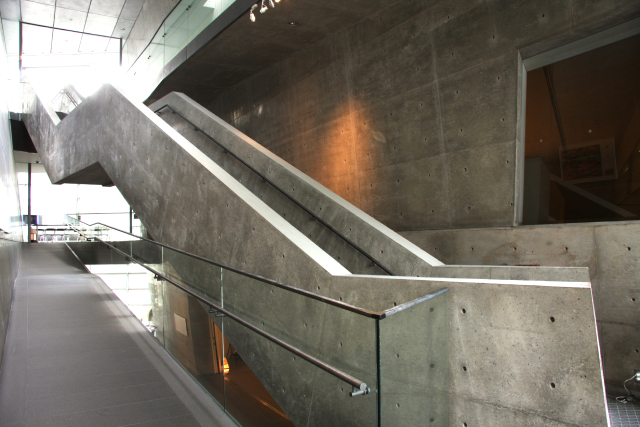
Enjoy a delicious Japanese-style breakfast at Nipponia, which prides itself on sourcing the best local produce from across the Ozu region. Perhaps step out to enjoy the town’s relaxed vibe and a quick expresso before departing mid-morning by train.
Your next stop is Matsuyama, Ehime’s attractive provincial capital and a former castle town steeped in feudal culture. The city’s superlative hilltop Matsuyama Castle dates back to 1602 and is one of the 12 remaining original castles left in Japan. Immaculately preserved, the expansive castle compound has an impressive tower, steeply angled stone walls and informative displays. Matsuyama is also home to venerable Dogo Onsen, believed to be the site of Japan’s oldest onsen (natural mineral hot springs) with a history spanning some 3,000 years! Today is all about enjoying the history and arts scene of this cultural city:
- Learn about Matsuyama’s bamboo-craft traditions in a small family-run studio specializing in “tiger-patterned” bamboo sourced locally
- Visit a textile studio which weaves the distinctive Ehime local fabric (Iyo-kasuri) using hand looms
- Admire the contemporary architecture of Ando Tadao’s Saka no Ue no Kumo Museum, nestled into the hillside beneath Matsuyama Castle
- Take the ropeway for a tour of Matsuyama Castle, enjoying the changing colours of the cherry and maple trees
- Stroll the charmingly retro arcades at Dogo Onsen, stop for a refreshing Dogo beer or freshly squeezed mikan juice, and enjoy a soak in Dogo’s onsen waters
Your accommodation tonight is an exquisite traditional ryokan inn, located near Dogo Onsen’s historic main building. You can soak in the onsen baths within your hotel or don your yukata robe and head to the public onsen. Enjoy an elaborate kaiseki banquet meal in your ryokan and a good night’s sleep on fluffy futons. Bliss!
Dogo Onsen (Yamatoya Honten or similar)
Breakfast, Dinner
Day 10: Seto Inland Sea and Omishima
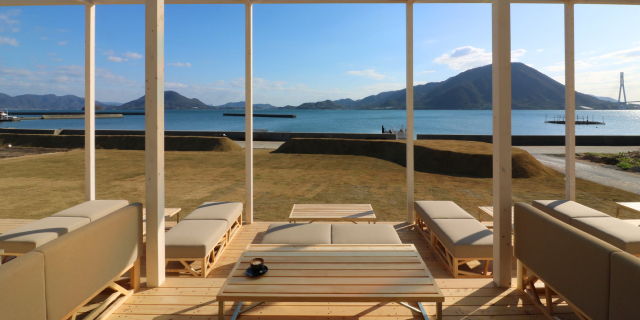
Leaving Shikoku’s mainland behind, we island-hop across the Seto Inland Sea to explore the relaxed pace of island life in this special part of Japan. Your first stop is Kiro-san Observatory for sweeping views of the sparkling Inland Sea with its stunning bridges and islands as far as the eye can see. The observatory was designed by Kengo Kuma and a notable sight in itself. Passing by traditional fishing villages and citrus groves, we head to Ito Toyo Museum for Architecture on Omishima island, the mid-point between Shikoku and Honshu and resting point for cyclists touring the famous 70km-long Shimanami Kaido cycling route.
You’ll check into Wakka, a contemporary boutique-style accommodation located right on the waterfront. Staying in a free-standing cabin, you will be just a short ramble from Wakka’s idyllic terrace cafe. You then hop on a bike for a guided cycling tour to beautiful Oyamazumi Shrine, one of the oldest shrines in western Japan. You’ll find a 2,600 year-old camphor tree in its sacred grounds and one of Japan’s best collections of samurai armoury, harking back to the time when powerful warlords and pirates controlled sea passage and trade. You’ll cycle past fresh seafood eateries, cute cafes and shops selling all sorts of citrus products and the local craft beer.
Enjoy a BBQ dinner at Wakka, with a splendid background of sunset views over the bridges and Inland Sea.
Omishima (Wakka or similar)
Breakfast, Dinner
Day 11: Imabari and Takamatsu
Enjoy a relaxed morning at Wakka before heading back to the Shikoku mainland where we make a brief stop at Imabari, the first town after crossing impressive Kurushima Kaikyo suspension bridge, one of the world’s longest. Here we briefly tour some noteworthy civic buildings designed by world-famous architect Kenzo Tange, whose father was an Imabari local.
Then it’s on to Takamatsu (where you began your Shikoku journey) by train, catching glimpses of the Seto Inland Sea on the way. You tour Isamu Noguchi Garden Museum which houses the works and studio of Isamu Noguchi, the influential mid-20th century sculptor, artist and landscape designer. Among other notable works, Noguchi designed the garden at UNESCO’s headquarters in Paris. For inspiration of a different kind, you head to George Nakashima Memorial Gallery to see how the world-renown furniture designer reshaped natural timbers into stunning pieces, such as his classic cantilever chair. Don’t miss the display of his famous “chigiri” butterfly joinery.
End the day with Takamatsu’s most popular soul food – succulent roasted chicken thighs!
Takamatsu (JR Clement Hotel or similar)
Breakfast, Dinner
Day 12: Takamatsu
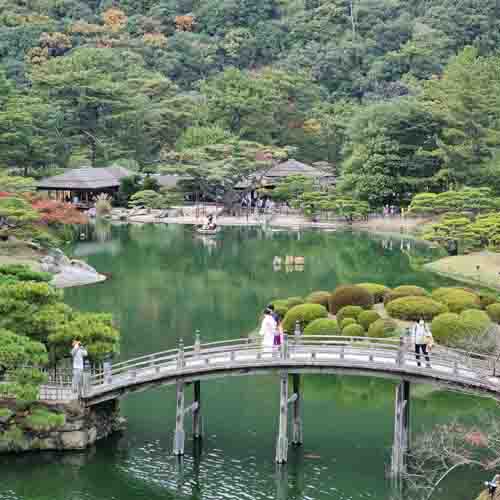
Start the day with a visit to Takamatsu’s main civic structure – the Kagawa Prefectural Government Office, which was also designed by Kenzo Tange. Symbolic of Japan’s modernism and democracy in the post-war period, this was the only Japanese building listed as one of the top 25 modern buildings of significance by the New York Times in 2021. Then it’s on to Higashiyama Kaii Setouchi Art Museum to view over 350 works, including landscape paintings and traditional woodblock prints by 20th century master-artist Higashiyama. Superbly designed by Yoshio Taniguchi, the building also provides impressive sea views.
You then head to superb Ritsurin Garden, one of Japan’s absolute best. especially in autumn and spring. A classic landscape garden from Edo times, enjoy the varied scenery provided by ponds, bridges and teahouses, superbly set against the backdrop of Mt Shiun. You take a leisurely cruise in a traditional boat steered by an oarsman and enjoy lunch in the park’s beautiful autumnal setting.
The rest of the day is yours to relax or explore. You may like to stroll through pleasant Tamamo Park where the seawater moat walls of Takamatsu’s former castle can still be seen, or wander the city’s retro shopping arcades or do a wasonbon confectionery class.
Takamatsu (JR Clement Hotel or similar)
Breakfast, Lunch
Day 13: Teshima and Takamatsu

The art islands of the Seto Inland Sea have led to a revitalisation of the region’s islands over the last decade. Now populated with galleries, outdoor installations, hotels and restaurants, the islands attract a steady stream of art lovers throughout the year.
Today you hop on a local ferry to tour the picturesque island of Teshima by private vehicle to see the Teshima Art Museum. Designed as a monumental concrete shell, it is shaped as a large tear-drop hugging the side of one of the island’s forested hills. You also visit Les Archives du Coeur for a fascinating experience of a different kind – this unique museum has changed the heartbeat of thousands across the globe.
Returning to Takamatsu in the afternoon, enjoy some time to yourself in this pleasant provincial capital with its welcoming restaurants and vibe.
Takamatsu (JR Clement Hotel or similar)
Breakfast
Day 14: Naoshima
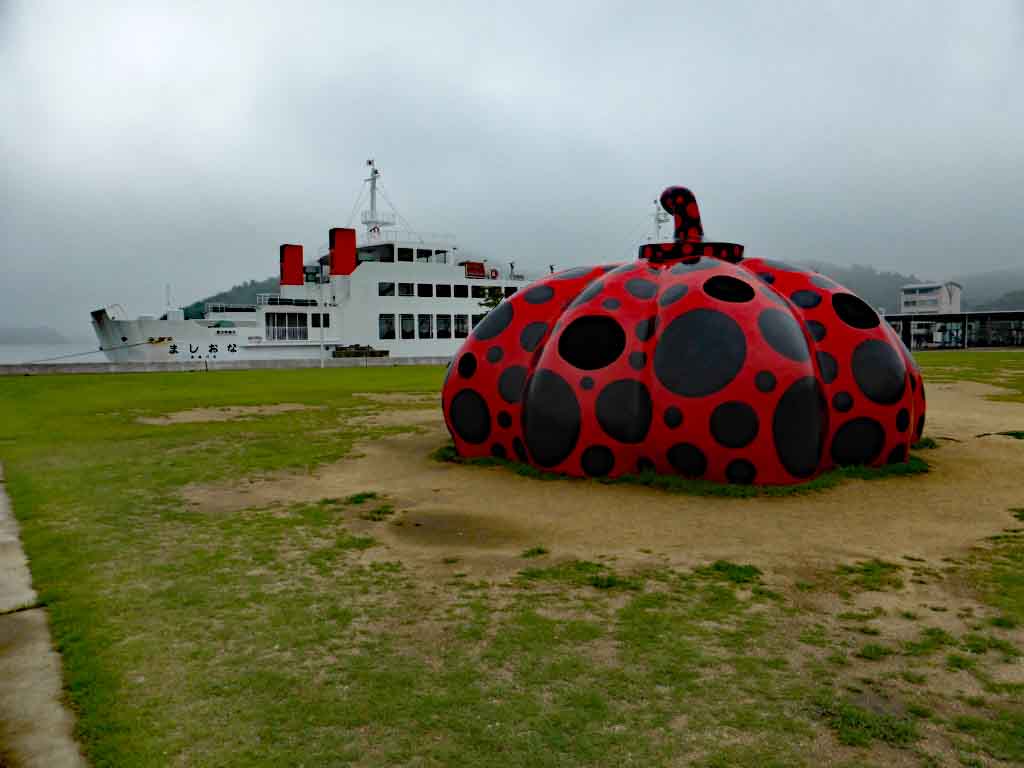
You are off to the main art island of Naoshima by ferry to see some of Japan’s best contemporary art located across the island’s natural setting. You tour the main sites by private vehicle, such as the Art House Project, Chichu Art Museum and the Lee Ufan Museum, as well Yayoi Kusama’s trademark pumpkin sculpture.
After an inspiring day spent outdoors check into your Naoshima accommodation, a beautifully designed Japanese contemporary-style ryokan. The ryokan features contemporary works of emerging artists, and each suite has its own private open-air bath. Enjoy a sumptuous inhouse kaiseki course meal to mark your final night in style!
Naoshima (Roka or similar)
Breakfast, Dinner
Day 15: Bon Voyage
This morning, you check out of your hotel after breakfast and your 2024 Architecture Tour Shikoku Japan concludes.
You can take a domestic flight from Takamatsu or return by train to the international airports in Tokyo or Osaka. If you’d like to linger in Japan a little longer, we would be delighted to plan your personal post-tour extension to show you a different part of Japan. Please see our Model Extension Itineraries for inspiration.
Note: The cost of a transfer to your departure airport is not included in our Small Group Tours as we found many guests choose to stay in Japan a bit longer. However, we would be happy to arrange your transfer to your next destination or your departing airport. Please see our FAQ for more details.
Breakfast
Dates & Prices
2024 Architecture Tour of Shikoku Japan
Per person twin share:
Single supplement
Inclusions
Each guest is personally looked after with one-on-one interactions with our hand-picked, expert tour guides. As part of your investment, this tour includes:
- First-class wisdom and higher standard of individual care and attention
- 14 nights’ accommodation (including traditional Japanese inns)
- All breakfasts
- 7 lunches (6 free choice lunches)
- 10 dinners (3 free choice dinners)
- Airport meet & greet on arrival
- All local transport (domestic flight from Haneda to Takamatsu, train and private minivans)
- Expert English speaking tour guides (locally licensed)
- Cultural activities and entry fees included in itinerary
- Luggage transfers (1 piece per person)
DISCLAIMER: Unless otherwise stated, this tour does not include the costs of international and domestic airfares, transfers on the last day, travel insurance, alcoholic and non-alcoholic beverages, transport during free time, personal expenses (laundry, internet, telephone, coin lockers etc.) and Visa (if required).
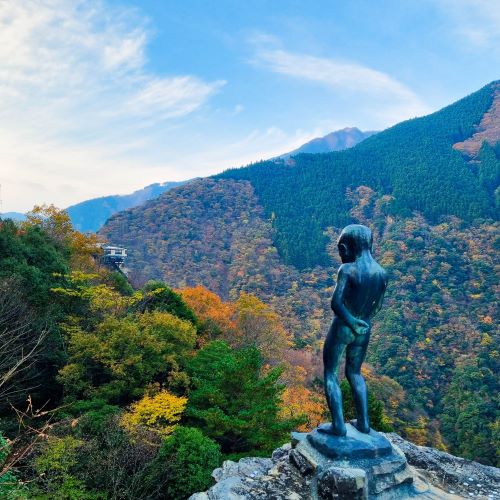
Who this Japan tour is for...
This is a perfect tour for people who:
- Want to see and stay in Japan’s unique architecture including renovated farm houses and historical buildings
- Wish to travel in remote areas of Japan away from typical tourist destinations
- Enjoy Japan’s traditional culture like food, onsen and crafts in more authentic settings
- Are interested in leaning about Japan’s feudal history, religions, and rural lifestyle
- Love the nature such as valleys, mountains, sea and islands
- Prefer a casual style small group tour with variety of accommodation, transport and meals
Reviews
Great attention to detail and flexibility were the strongest points.
5/5
Trip date: November 2023
Alla Toff
USA
JttE sets the gold standard for customer service and care every single step of the way from enquiry to booking to the actual trip itself. Communications are prompt and clear. Transportation connections between buses, planes, ferries, and taxis are seamless. Every consideration is given to make the guest experience stressless and enjoyable. This was our 2nd trip with JttE. Thanks to the whole team for a great time !!!
4/5
Trip date: November 2023
Jane Wang
USA
Journey to the East is a niche tour operator which introduces you to amazing places, combining art and gardens, food, architecture in unusual places such as Hokkaido, Naoshima and Shikoku.
5/5
Trip date: November 2023
Philip Manidis
Sydney, Australia
Journey to the East puts their heart and soul into creating wonderful times for visitors to Japan. They know it well and share the best of it with you. They work hard to offer experiences that become treasured memories – of people, places, events … and food!
5/5
Trip date: November 2023
